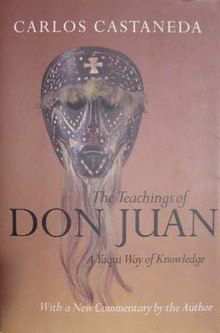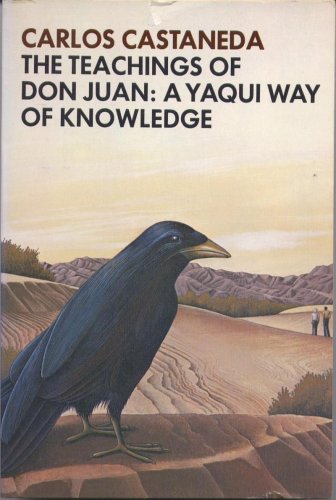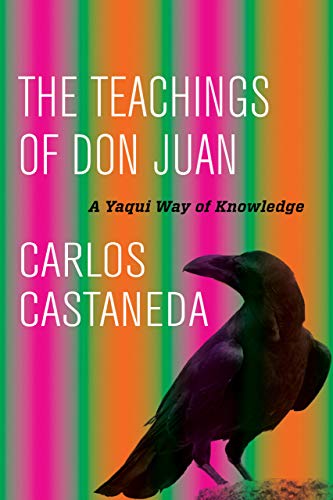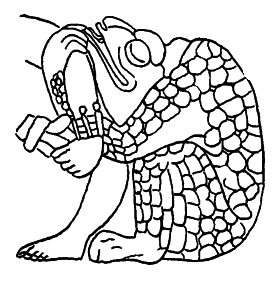ドン・ファンの教え
The Teachings of Don Juan, Las enseñanzas
de Don Juan 1968
以下は、ウィキペディアなどからの情報である。☆『ドン・ファンの教え:ヤキ族の知恵』(原 題:The Teachings of Don Juan: A Yaqui Way of Knowledge)は、カルロス・カスタネダが人類学の修士論文として執筆した本です。1968年にカリフォルニア大学出版局から英語で、1974年に スペイン語で出版されました。この本は、1960年から1965年にかけて、著者がソノラ州(メキシコ)のヤキ族の邪術師でありナグアルであるフアン・マ トゥスとともに過ごした経験を綴ったものです。 この本は2つのセクションに分かれています。最初のセクション「教え」は、カスターネダがドン・ファンと3種類の向精神植物(ペヨーテ[注1]、トロア チェ(Datura inoxia)、Psilocybe (おそらくPsilocybe mexicana)[1]、そしてこれらの物質を摂取することで到達した非日常的な現実の状態[注2]について記録した一人称の物語で構成されています。 本の後半では、著者は「ドン・ファンの教えの内部の結束と偶然性」を明らかにするために構造分析を行っています。 この本に記述されている事実の真実性は、カスターネダの他の作品と同様、論争の的となっており、一部の人々はこれを欺瞞だと考えているが、他の人々はこれ を本物の本だと考えている。[2] 時系列的には、これは4冊からなるシリーズの第1作目で、その後、9冊からなる第2シリーズが連続して出版されている。(参照:カルロス・カスターネダの 著作)
| Las enseñanzas de
Don Juan: una forma yaqui de conocimiento (del inglés: The Teachings of
Don Juan: A Yaqui Way of Knowledge) es un libro escrito por Carlos
Castaneda como su tesis de maestría en antropología. Se publicó por
primera vez en 1968 en inglés por la University of California Press y
en 1974 en español. El libro narra las vivencias del autor junto a un
brujo y nagual yaqui del estado de Sonora (México), llamado Juan Matus,
entre 1960 y 1965. El libro está dividido en dos secciones. La primera sección, Las enseñanzas, es una narrativa en primera persona que documenta las interacciones iniciales de Castaneda con Don Juan usando tres tipos de plantas psicotrópicas: el peyote,[nota 1] el toloache (Datura inoxia) y un hongo de la familia Psilocybe (probablemente Psilocybe mexicana)[1] y los estados de realidad no ordinaria[nota 2] alcanzados mediante el consumo de dichas sustancias. En la segunda parte del libro, el autor realiza un análisis estructural buscando "revelar la cohesión y contingencia interna de las enseñanzas de Don Juan". La veracidad de los hechos relatados, al igual que la del resto de la obra de Castaneda, ha sido fuente de polémica, considerándose un caso de engaño para algunos, mientras que para otros se trata de un libro auténtico.[2] Cronológicamente, es el primer libro de una colección de cuatro libros, seguida sucesivamente de una segunda saga de nueve más. (Ver: Publicaciones de Carlos Castaneda) |
『ドン・ファンの教え:ヤキ族の知恵』(原題:The
Teachings of Don Juan: A Yaqui Way of
Knowledge)は、カルロス・カスタネダが人類学の修士論文として執筆した本です。1968年にカリフォルニア大学出版局から英語で、1974年に
スペイン語で出版されました。この本は、1960年から1965年にかけて、著者がソノラ州(メキシコ)のヤキ族の邪術師でありナグアルであるフアン・マ
トゥスとともに過ごした経験を綴ったものです。 この本は2つのセクションに分かれています。最初のセクション「教え」は、カスターネダがドン・ファンと3種類の向精神植物(ペヨーテ[注1]、トロア チェ(Datura inoxia)、Psilocybe (おそらくPsilocybe mexicana)[1]、そしてこれらの物質を摂取することで到達した非日常的な現実の状態[注2]について記録した一人称の物語で構成されています。 本の後半では、著者は「ドン・ファンの教えの内部の結束と偶然性」を明らかにするために構造分析を行っています。 この本に記述されている事実の真実性は、カスターネダの他の作品と同様、論争の的となっており、一部の人々はこれを欺瞞だと考えているが、他の人々はこれ を本物の本だと考えている。[2] 時系列的には、これは4冊からなるシリーズの第1作目で、その後、9冊からなる第2シリーズが連続して出版されている。(参照:カルロス・カスターネダの 著作) |
| Estructura Introducción El autor relata la manera en la que conoció a Don Juan, se habla brevemente del maestro de Don Juan “un diablero”, el autor realiza una reflexión sobre las experiencias vividas durante los cinco años en que fue aprendiz de Don Juan, se habla sobre las plantas usadas, estados de realidad no ordinaria, poder, objetos de poder y el aliado. |
構造 序文 著者は、ドン・ファンと出会った経緯を語り、ドン・ファンの師匠である「悪魔師」について簡単に触れている。著者は、ドン・ファンの弟子として過ごした 5 年間の経験について考察し、使用された植物、非日常的な現実の状態、力、力の対象、そして同盟者について述べている。 |
| Parte I: Las Enseñanzas Capítulo 1 Carlos Castañeda pide ser instruido sobre la planta de peyote o mescalito como lo llamaba Don Juan, Don Juan le señala que “podrá tener en cuenta dicha petición siempre y cuando [Castaneda] poseyera claridad de mente y propósito con respecto a lo que le había preguntado”. Don Juan pide a Carlos Castañeda encontrar su sitio en el zaguán sintiéndolo con los ojos. Tras horas intentando encontrar su sitio Castaneda finalmente encuentra “el sitio” y “el enemigo”. Don Juan le dice a Castaneda que “[…] estos dos lugares [son] la clave del bienestar de un hombre, especialmente si [busca] conocimiento. El mero acto de sentarse en el sitio propio [crea] fuerza superior; en cambio, el enemigo [debilita] e incluso [puede] causar la muerte”. Don Juan le señala a Castaneda que conocer a Mezcalito no es ningún chiste, "Mezcalito pide una intención muy seria". |
第1部:教え 第1章 カルロス・カスタネダは、ドン・ファンが「ペヨーテ」または「メスカリート」と呼んでいた植物について教えを請う。ドン・ファンは、「カスタネダが、自分の質問について明確な心構えと目的を持っている限り、その願いを聞き入れる」と答える。 ドン・ファンは、カルロス・カスタニェダに、目で見えるように感じながら、玄関で自分の場所を見つけるよう指示する。何時間も自分の場所を探し続けたカス タニェダは、ついに「その場所」と「敵」を見つける。ドン・ファンは、カスタニェダに「[…] この 2 つの場所は、特に知識を求める者にとって、幸福の鍵となる」と告げる。自分の場所に座るという行為そのものが、より大きな力を生み出す。一方、敵は力を弱 め、さらには死をもたらすこともある」。 ドン・ファンは、メスカリートを知ることは冗談ではないとカスターニャダに指摘する。「メスカリートは、非常に真剣な意図を求めている」。 |
| Capítulo 2 Se relata la primera experiencia en la que Castañeda consume peyote (conoce a Mescalito). Al intentar Castañeda entender su estado a partir del estado de realidad ordinaria siente deseos de finalizar su proceso de aprendizaje; sin embargo, para Don Juan que Mescalito jugara con Castañeda es una señal de que puede compartir sus secretos con él. Don Juan le dice a Castañeda que le va a enseñar no solo sobre Mescalito sino también sobre “el aliado”,[nota 3] Don Juan señala que Mescalito es otra clase de poder, “un protector, un maestro”. |
第2章 カスターニャーダがペヨーテを初めて体験した(メスカリートと出会った)エピソードが語られる。カスターニャーダは、通常の現実の状態から自分の状態を理 解しようとした結果、学習のプロセスを終わらせたいと思うようになる。しかし、ドン・ファンにとっては、メスカリートがカスターニャーダと遊んだことは、 彼に自分の秘密を明かすことができるという合図だった。 ドン・ファンはカスターニャダに、メスカリトだけでなく「盟友」についても教えると言う[注3]。ドン・ファンは、メスカリトは別の種類の力、「守護者、師」であると指摘する。 |
| Capítulo 3 Don Juan habla sobre los dos aliados que conoce, "la yerba del diablo" y "el humito". Enseña la preparación de las mezclas alucinógenas y finalmente habla sobre el "hombre de conocimiento" y los cuatro enemigos naturales del hombre. La "yerba del diablo" (Datura inoxia) es un aliado que en palabras de Don Juan "malogra a los hombres, [ya que] les hace probar el poder demasiado pronto, sin fortificar sus corazones, y los hace dominantes y caprichosos". Don Juan relata que aquel hombre que quiera a la "yerba del diablo" como aliado toma las raíces y las semillas (especialmente estas últimas), dejando las flores, el tallo y las hojas. Don Juan enseña a Castañeda el método de extracción de la raíz de la "yerba del diablo" y le señala que es un aliado que se usa solamente para dar poder. "El humito" (un hongo de la familia Psilocybe, probablemente Psilocybe mexicana) es un aliado que dice qué hacer, "es un aliado que se utiliza para observar y ver, y una vez un hombre entra en su campo, todos los otros poderes están a su disposición". Es el aliado preferido por Don Juan (quien enseña el uso de la “yerba del diablo” pero no lo recomienda, pues en su opinión solo los brujos ambiciosos y ávidos de acceder rápidamente al poder la utilizan). El “humito” consiste en dos partes, la pipa y la mezcla de fumar. Su preparación debe ser enseñada, ya que es un veneno mortal, y sus efectos tan terribles que solo un hombre fuerte que se ha preparado llevando una vida dura y tranquila puede soportar la más pequeña fumada. El mayor don del "humito" es que lleva a cabo su función sin dañar en lo más mínimo. Don Juan señala que un hombre de conocimiento es "alguien que ha seguido de verdad las penurias de aprender. Un hombre que sin apuro, sin vacilación, ha ido lo más lejos que puede en desenredar los secretos del poder y el conocimiento". Los cuatro enemigos naturales que un hombre debe vencer para convertirse en un hombre de conocimiento son: El miedo La claridad El poder La vejez |
第3章 ドン・ファンは、彼が知っている2つの味方、「悪魔の草」と「煙」について語る。幻覚作用のある混合物の作り方を教え、最後に「知識の人」と人間の4つの天敵について語る。 「悪魔の草」(Datura inoxia)は、ドン・フアンの言葉によると、「人間を台無しにする」同盟者だ。「なぜなら、それは人間に力をあまりにも早く味わわせ、心を強靭にしな いまま、支配的で気まぐれな人間にしてしまうからだ」。ドン・ファンは、「悪魔の草」を味方として望む者は、根と種子(特に種子)を取り、花、茎、葉は残 す、と語る。ドン・ファンは、カスターニャーダに「悪魔の草」の根の抽出方法を教え、これは力だけを与えるために使用される味方だと指摘する。 「エル・ウミト」(Psilocybe 属のキノコ、おそらく Psilocybe mexicana)は、何をすべきかを指示する味方であり、「観察し、見るために使用される味方で、一度その領域に入ると、他のすべての力が利用可能にな る」と説明しています。これは、ドン・ファン(悪魔の草の使用法を教えているが、野心的で、すぐに力を手に入れたいと願う邪術師だけが使うと主張し、その 使用を推奨していない)が好む味方だ。「フミト」は、パイプと喫煙用の混合物の2つの部分から成る。これは致命的な毒であるため、その調製方法は教えられ なければならない。その効果は恐ろしく、過酷で静かな生活を送って準備を整えた強い人間でなければ、ごくわずかな喫煙でも耐えられない。フミトの最大の恩 恵は、その機能をまったく害することなく果たすことだ。 ドン・ファンは、知識のある人間とは「学びの苦難を真に経験した者。焦ることなく、躊躇することなく、権力と知識の秘密を解き明かすためにできる限りのことをした者」だと指摘している。人間が知識のある人間になるために克服しなければならない4つの天敵は、次のとおりだ。 恐怖 明晰さ 権力 老い |
| Capítulo 4 Don Juan habla acerca de Mescalito y Castaneda tiene su segundo encuentro con Mescalito. Según Don Juan, Mescalito es un protector y un maestro, es un protector para aquellos que "le gustan" aunque también daña a cierta gente porque "lo buscan con la idea de sacar provecho sin trabajar", para aquellas personas que carecen de un aliado[nota 4] Mescalito puede cumplir una función de protección viendo que nada malo le pase a uno. Don Juan señala que cuando Mescalito acepta por completo a alguien se le aparece como un hombre, o como una luz, cuando alguien ha ganado esta clase de aceptación, "Mescalito es constante, ya no vuelve a cambiar después, y algún día incluso puede llevarlo a uno a volar y revelarle todos sus secretos; [sin embargo], para llegar a ese punto uno tiene que ser un hombre fuerte y la vida de uno tiene que ser verdadera, una vida que se vive con la certeza nítida de estarla viviendo, una vida fuerte". Don Juan y Castañeda realizan un viaje para juntar un poco de Mescalito, Don Juan explica a Castañeda que "[a Mescalito] lo recogeremos solo cuando se nos presente en nuestro camino. Él nos encontrará y no al revés. Él nos encontrara... si quiere". Adicionalmente Don Juan señala que no es necesario beber en esta búsqueda y cuando Castañeda pide si podía encender un fuego Don Juan reacciona como si fuera inconcebible preguntar tal cosa. Don Juan señala que "por esta noche [somos] huéspedes de Mescalito y [...] él nos daría calor". Durante el crepúsculo[nota 5] Don Juan y Castañeda consumen catorce botones de peyote y Castañeda logra percibir a Mescalito como una entidad antropomórfica y le da a Castañeda la respuesta a una pregunta. Esta señal es vista por Don Juan como una de buen augurio e inician la recolecta de peyote. Don Juan comenta a Castañeda que el protector le puede enseñar canciones que son un vínculo entre ellos, estas canciones deben ser enseñadas por el protector y no deben ser copiadas de otras personas. Así mismo Don Juan señala que el verdadero nombre de Mescalito no puede ser pronunciado más que para llamarlo. |
第4章 ドン・ファンはメスカリートについて語り、カステジャーナはメスカリートと2度目の出会いをします。 ドン・ファンによると、メスカリトは守護者であり師であり、彼を「好む」者たちを守る存在だが、一方で「働かずに利益を得ようとして彼を求める」者たちに は害を及ぼす。同盟者を持たない者たち[注4]に対して、メスカリトは彼らに悪いことが起こらないよう保護する役割を果たす。ドン・ファンは、メスカリー トが誰かを完全に受け入れたとき、その人に男として、あるいは光として現れると指摘している。この種の受け入れを得た人は、「メスカリートは不変であり、 その後もう変わることはなく、いつかその人を空に飛ばして、すべての秘密を明かすこともある」と。[しかし]、その段階に達するためには、人は強い人間で なければならないし、人生は真実でなければならない。つまり、自分が生きていることを明確に認識して生きる、強い人生でなければならない」と述べる。 ドン・ファンとカスタニェダは、メスカリトを少し集める旅に出る。ドン・ファンはカスタニェダに、「[メスカリトは] 私たちの道に現れたときにだけ採るんだ。彼が私たちを見つけるんだ。その逆じゃない。彼が私たちを見つける…もし彼が望むなら」と説明する。さらにドン・ ファンは、この探求では飲む必要はないと指摘し、カスターニャーダが火を点けてもいいかと尋ねると、ドン・ファンはそんなことを聞くことが考えられないか のように反応する。ドン・ファンは、「今夜は私たちはメスカルイトの客であり、…彼が私たちに暖かさを与えてくれるだろう」と指摘する。 夕暮れ[注 5]、ドン・ファンとカスターニャーダは 14 個のペヨーテのボタンを摂取し、カスターニャーダはメスカリートを擬人化された存在として認識し、メスカリートから質問に対する答えを得る。ドン・ファン はこれを吉兆と捉え、ペヨーテの収集を始める。ドン・ファンはカスターニャーダに、守護神は彼らを結ぶ歌を教えてくれると語る。これらの歌は守護神から教 えられなければならず、他の人から真似してはいけない。また、ドン・ファンは、メスカリートの本当の名前は、彼を呼ぶとき以外は口にしてはいけないと指摘 する。 |
| Capítulo 5: Don Juan le confiesa a Castaneda que la hierba del diablo no es para él, Castaneda le pregunta que cómo pudo llegar a esa conclusión y Don Juan le responde que las veces que intentó usar la hierba del diablo casi le cuesta la vida, que él pudo haber evitado ese dolor si no se hubiese aferrado. Castaneda le pregunta cuál es la manera para evitar el dolor y Don Juan le contestó que no es algo que requiere de una fórmula ni de ningún procedimiento: - "Es una manera de agarrarse a las cosas (...) La yerba del diablo es solo un camino entre cantidades de caminos. Cualquier cosa es un camino entre cantidades de caminos. Por eso debes tener siempre presente que un camino es solo un camino; si sientes que no deberías seguirlo, no debes seguir en él bajo ninguna condición. Para tener esa claridad debes llevar una vida disciplinada. Solo entonces sabrás que un camino es nada más un camino, y no hay afrenta, ni para ti ni para otros, en dejarlo si eso es lo que tu corazón te dice. Pero tu decisión de seguir en el camino o de dejarlo debe estar libre de miedo y de ambición. Te prevengo. Mira cada camino de cerca y con intención. Pruébalo tantas veces como consideres necesario. Luego hazte a ti mismo, y a ti solo, una pregunta. Es una pregunta que solo se hace un hombre muy viejo. Mi benefactor me habló de ella una vez cuando yo era joven, y mi sangre era demasiado vigorosa para que yo la entendiera. Ahora sí la entiendo. Te diré cuál es: ¿tiene corazón este camino? Todos los caminos son lo mismo: no llevan a ninguna parte. Son caminos que van por el matorral. Puedo decir que en mi propia vida he recorrido caminos largos, largos, pero no estoy en ninguna parte. Ahora tiene sentido la pregunta de mi benefactor. ¿Tiene corazón este camino? Si tiene, el camino es bueno; si no, de nada sirve. Ningún camino lleva a ninguna parte, pero uno tiene corazón y el otro no. Uno hace gozoso el viaje; mientras lo sigas, eres uno con él. El otro te hará maldecir tu vida. Uno te hace fuerte; el otro te debilita". |
第5章: ドン・ファンはカスターニャに、悪魔の草は自分には向いていないと告白する。カスターニャは、なぜそう結論付けたのかを尋ねると、ドン・ファンは、悪魔の 草を使ったたびに命を失いかけたからだと答える。そして、その草に固執しなければ、その苦痛は避けられただろうとも言う。カスターニャは、その痛みを避け る方法を尋ねると、ドン・ファンは、それは公式や手順でできるものではないと答える。 - 「それは物事に固執する方法だ(...)。悪魔の草は、無数の道のうちのひとつの道にすぎない。何事も、数多くの道のうちのひとつの道に過ぎない。だか ら、道はただひとつの道に過ぎないことを常に心に留めておかなければならない。その道を進むべきではないと感じたなら、いかなる状況でもその道を進んでは ならない。その明確さを得るためには、規律ある生活を送らなければならない。そうして初めて、道はただひとつの道に過ぎないことを理解でき、自分の心がそ う告げるなら、その道から離れることは、自分にも他人にも何の恥でもないことを理解できるだろう。しかし、その道を進むか、それとも離れるかの決断は、恐 れや野望から解放されたものでなければならない。注意しておこう。それぞれの道をよく、そして意図的に見極めて。必要だと思うだけ何度でも試してみよう。 そして、自分だけに、そして自分だけに、一つの質問をしてみよう。それは、非常に老いた人間だけが自問する質問だ。私の恩人が、私が若かった頃、この質問 について話してくれた。しかし、私の血は若すぎて、その意味を理解できなかった。今、私はその意味を理解している。その質問とは、「この道には心がある か?」だ。すべての道は同じだ。どこにも通じていない。雑木林の中を走る道だ。私自身、人生で長く、長い道を歩んできたと言えるが、どこにもたどり着いて いない。今、恩人の質問の意味がわかった。この道には心があるか?あるなら、その道は良い道だ。ないなら、何の役にも立たない。どの道もどこにも通じてい ないが、ある道には心があり、別の道には心がない。ある道は旅を楽しいものにする。その道を進む限り、あなたは道と一体になる。別の道は、あなたの人生を 呪うことになる。ある道はあなたを強くし、別の道はあなたを弱体化させる。 |
| Parte II: Análisis estructural Aquí es donde el mismo autor analiza los contenidos de la primera parte con el fin de revelar la cohesión interna y la fuerza lógica de las enseñanzas de Don Juan. Para esto compone cuatro conceptos como unidades principales: Hombre de conocimiento Un hombre de conocimiento tenía un aliado Un aliado tenía una regla La regla se corroboraba por consenso especial Estas cuatro unidades se componen a su vez de ideas subsidiarias y así la estructura total compone todos los conceptos significativos hasta el momento en que abandonó su aprendizaje. |
第2部:構造分析 ここでは、同じ著者が第1部の内容を分析し、ドン・ファンの教えの内部の結束力と論理的な強さを明らかにしている。このために、4つの概念を主要な単位として構成している。 知識のある人間 知識人は味方を持っていた 味方は規則を持っていた 規則は特別な合意によって確認されていた これらの4つの単位はさらに補助的なアイデアから構成されており、全体構造は彼が学びを放棄するまでの時点で重要なすべての概念を包含している。 |
| neotoltecas Pueblo Yaqui (Sonora) pueblo yaqui El arte de ensoñar Carlos Castaneda toltequidad La regla del nagual |
ネオトルテカ ヤキ族(ソノラ州 ヤキ族 夢を見る芸術 カルロス・カスタネダ トルテカ性 ナグアルの法則 |
| 1. En el contexto de la obra se habla del peyote como «mescalito». 2. Estados de realidad inusitada contrapuestos a la realidad ordinaria de la vida cotidiana 3. “Un “aliado” es un poder que un hombre puede traer a su vida para que lo ayude, lo aconseje, y le dé la fuerza necesaria para ejecutar acciones. […] Este aliado es la ayuda indispensable para saber”. 4. Los poderes aliados solo están a disposición de los brujos, pero cualquiera puede disponer de Mescalito. 5. Don Juan señala que éste es la raja entre los mundos. |
1. この作品では、ペヨーテは「メスカリート」と呼ばれている。 2. 日常生活の通常の現実とは対照的な、異常な現実の状態 3. 「同盟者」とは、人間が自分の人生に呼び寄せ、助けや助言を得、行動に必要な力を与えてくれる力のことだ。[…] この同盟者は、知識を得るために欠かせない助けとなる。 4. 同盟者の力は、魔術師だけが利用できるが、メスカリートは誰でも利用することができる。 5. ドン・ファンは、これが世界間の境界線であると指摘している。 |
| Castañeda, Carlos (1974). Las enseñanzas de Don Juan. México: Fondo de Cultura Económica. «The dark legacy of Carlos Castaneda». 14 de octubre de 2008. Archivado desde el original el 17 de septiembre de 2008. Castaneda, Carlos (1968). Las Enseñanzas de Don Juan: Una forma Yaqui de conocimiento. California: University of California Press. |
カスターニャーダ、カルロス(1974)。『ドン・ファンの教え』。メキシコ:フォンデ・デ・カルチュラ・エコノミカ。 「カルロス・カスターニャーダの暗い遺産」。2008年10月14日。2008年9月17日にオリジナルからアーカイブ。 カスターニャーダ、カルロス(1968)。『ドン・ファンの教え:ヤキ族の知恵』。カリフォルニア:カリフォルニア大学出版局。 |
| https://es.wikipedia.org/wiki/Las_ense%C3%B1anzas_de_Don_Juan |
☆






"The Teachings of Don Juan" は、カルロス・カスタネダ(Carlos Castaneda, 1925-1998)の処女作。UCLAの社会学の修士論文がもとになる(→カルロス・カスタネダ頌)。カスタネダの最初のメンターの一人は、ハロルド・ガー フィンケル (Harold Garfinkel, 1917-2011)と言われる。前半は、ヤキ先住民(Yaqui) のドン・ファン・マトゥースという呪術師と出会い、さまざまな幻覚性植物の助けをかりて、精神飛翔(トリップ)の 実践をし、ドンファンが投げかけてくる哲学的(あるいはニューエイジ的)審問に答えてゆくカスタネダの自伝的ドキュメント。当時のアメリカ大陸のニューエ イジブームに乗り、大ベストセラーと大ロングセラーになり、本書をはじめ、ほとんどの書物が邦訳されている。後半は、現象学理論をつかった多元的リアリ ティ論。前半は、ドン・ファンという精神的師匠(グル)は確かにいただろうが、複数の人物の合成と、さまざまな同地域の民族誌=エスノグラフィーや報告書などからのパッチ ワークだと、のちの同あるいは近隣地域の民族誌を研究する研究者・人類学者に批判されている。後半の現象学的記述の部分は、アルフレッド・シュッツのよう な、グノーシス的な記述に満ち溢れおり、後に出版されるようになる、 バーガー&ルックマン『現実の社会的構成(The social construction of reality : a treatise in the sociology of knowledge, 下記に目次の項目を示す)』には、劣るものの、ロバート・マートン流の「わかりやすい(=つまりナイーブ/シンプルな)」機能主義からは、独立した文 化相対主義から個人の意識の認識論的相対主義への「離床・離陸」が みられる点で興味深い。
"Starting with The Teachings of Don Juan in 1968, Carlos Castaneda wrote a series of books that describe his training in shamanism, particularly with a group whose lineage descended from the Toltecs. The books, narrated in the first person, relate his experiences under the tutelage of a man that Castaneda claimed was a Yaqui "Man of Knowledge" named don Juan Matus. His 12 books have sold more than 28 million copies in 17 languages. They have been found to be fiction, but supporters claim the books are either true or at least valuable works of philosophy./ Castaneda withdrew from public view in 1973, living in a large house in Westwood, California from 1973 until his death in 1998, with three colleagues whom he called "Fellow Travellers of Awareness." He founded Cleargreen, an organization that promotes "tensegrity", which Castaneda described as the modern version of the "magical passes" of the shamans of ancient Mexico." - Carlos Castaneda.
"The
Teachings of Don Juan: A Yaqui Way of Knowledge
was published by the University of California Press in 1968 as a work
of anthropology, though many critics contend that it is a work of
fiction.[1] It was written by Carlos Castaneda and submitted as his
Master's thesis in the school of Anthropology. It purports to document
the events that took place during an apprenticeship with a
self-proclaimed Yaqui Indian Sorcerer, don Juan Matus from Sonora,
Mexico between 1960 and 1965.
The book is divided into two sections.
The first section, The Teachings, is a first-person narrative that documents Castaneda's initial interactions with don Juan. He speaks of his encounters with Mescalito (a teaching spirit inhabiting all peyote plants), divination with lizards and flying using the "yerba del diablo" (lit. "Devil's Weed"; Jimson weed), and turning into a blackbird using "humito" (lit. "little smoke"; a smoked powder containing Psilocybe mexicana).
The
second, A Structural Analysis, is an attempt, Castaneda says, at
"disclos[ing] the internal cohesion and the cogency of don Juan’s
Teachings."[2]
The 30th-anniversary edition, published by the University of California
Press in 1998, contains commentary by Castaneda not present in the
original edition. He writes of a general discouragement from the
project by his professors (besides Clement Woodward Meighan,
a professor who supported the project early in its conception. In the
foreword, Castaneda gives "full credit" for the approval of his
dissertation to Meighan). He offers a new thesis on a mind-state he
calls "total freedom" and claims that he used the teachings of his
Yaqui shaman as "springboards into new horizons of cognition".[3]
In addition, it contains a foreword by anthropologist Walter
Goldschmidt
(1913-2010), who was a professor of anthropology at UCLA during the
time the books were written, and an introduction by the author. A 40th
anniversary edition was published by the University of California Press
in 2008." - https://en.wikipedia.org/wiki/The_Teachings_of_Don_Juan
後年の作品になるが、ウィチョル先住民のペヨーテを つかった儀礼の民族誌を書いたバーバラ・マイヤーホフなどの民族誌(ちなみにバーバラのドン・ファンは、Ramon Medina Silva である。後者はもちろん実在した)がある。
Barbara G. Myerhoff,
Peyote hunt : the sacred journey of the Huichol Indians. Cornell
University Press, 1974: ""Ramon Medina
Silva,
a Huichol Indian shaman priest or mara'akame, instructed me in many of
his culture's myths, rituals, and symbols, particularly those
pertaining to the sacred untiy of deer, maize, and peyote. The
significance of this constellation of symbols was revealed to me most
vividly when I accompanied Ramon on the Huichol's annual ritual return
to hunt the peyote in the sacred land of Wirikuta, in myth and probably
in history the place from which the Ancient Ones (ancestors and deities
of the present-day Indians) came before settling in their present home
in the mountains of the Sierra Madre Occidental in north-central
Mexico. My work with Ramon preceded and followed our journey, but it
was this peyote hunt that held the key to, and constituted the climax
of, his teachings."-from the Preface; 1. Ramon and Lupe; 2.
Ethnographic and Historical Background; 3. Huichol Religion; 4. The
Peyote Hunt as an Event; 5. The Deer-Maize-Peyote Complex; 6. The
Purpose and Meaning of the Peyote Hunt; Bibliography; Index"
●ドン・ファンの教え、その構造
| ●ドン・ファンの教え、その構造,
1968 -1. まえがき 0. 序文 第一部 教え 1. 私の最良の場所 2. メスカリトとの出会い 3. ダツラの体験と煙の準備 4. メスカリトとの再会 5. トカゲの呪術 6. ダツラでの飛行 7. 体が消える煙の体験 8. メスカリトの教え 9. もうひとつのトカゲの呪術 10. カラスへの変身 11. 魂の奪回 第二部 構造分析 12. 実存的秩序 13. 付録A 14. 付録B |
●Peter L. Berger
and Thomas Luckmann, The Social Construction of Reality: A Treatise in
the Sociology of Knowledge, 1966. The Problem of the Sociology of Knowledge 11 ONE THE FOUNDATIONS OF KNOWLEDGE IN EVERYDAY LIFE 31 1. The Reality of Everyday Life 33 2. Social Interaction in Everyday Life 43 3. Language and Knowledge in Everyday Life 49 TWO SOCIETY AS OBJECTIVE REALITY 63 1. Institutionalization 65 ......Organism and Activity 65 ......Origins of Institutionalization 70 ......Sedimentation and Tradition 85 ......Roles 89 ......Scope and Modes of Institutionalization 97 2. Legitimation 110 ......Origins of Symbolic Universes 110 ......Conceptual Machineries of Universe-Maintenance 122 ......Social Organization for Universe-Maintenance 134 THREE SOCIETY AS SUBJECTIVE REALITY 147 1. Internalization of Reality 149 ......Primary Socialization 149 ......Secondary Socialization 157 ......Maintenance and Transformation of Subjective Reality 166 2. Internalization and Social Structure, 183 3 Theories about Identity 194 4 Organism and Identity 201 CONCLUSION The Sociology of Knowledge and Sociological Theory 205 NOTES 213 INDEXES Subject Index 237 Name Index for Introduction and Notes 247 |
++++
-1. まえがき——ウォルター・ゴールドシュミッ ト
0. 序文
第一部 教え
1. 私の最良の場所
1961.06.23
1961.06.25
2. メスカリトとの出会い
1961.08.07
1961.08.05
1961.08.06
1961.08.17
1961.08.20
3. ダツラの体験と煙の準備
1961.08.23
1961.09.03
1961.09.06
1961.09.10
1961.11.23
1961.12.26
1962.01.27
1962.04.08
1962.04.15
4. メスカリトとの再会
1961.12.24
1962.01.30
1962.04.12
1962.04.14
1962.07.06
1962.07.03 - 128ページ
5. トカゲの呪術
1963.01.27
1963.01.28
1963.04.21
1963.04.18
1963.04.19
6. ダツラでの飛行
1963.06.27
1963.06.29
1963.07.06
7. 体が消える煙の体験
1963.12.23
1963.12.24
1963.12.31
1963.12.28
1964.01.28
8. メスカリトの教え
1964.09.12
1964.09.10
1964.09.11
9. もうひとつのトカゲの呪術
1964.12.28※日付が逆転するが、原文の まま、曜日も正しい
1964.12.24
1964.12.26
1964.12.28
10. カラスへの変身
1964.12.31
1965.01.17
1965.01.20
1965.02.07
1965.03.28
1965.03.23
1965.04.03
1965.04.04
1965.04.10
11. 魂の奪回
1965.10.29
第二部 構造分析
12. 実存的秩序
12.01 第一単位
知者
知者になることは学習の問題である
知者は不屈の意志をもつ
知者は心の明晰さをもつ
知者になることは厳しい努力の問題である
知者は戦士である
知者になることは止まることのない道程である
12.02 第二単位
知者は盟友をもつ
盟友は無形である
盟友はある特性として知覚される
盟友は馴らすことができる
12.03 第三単位
盟友には規則がある
規則は曲げられない
規則は累積できない
規則は日常的現実において確証される
規則は非日常的現実において確証される
12.04 第四単位
規則は独自な合意によって確証される
師
独自な合意の準備
独自な合意の導入
12.05 概念的秩序
弟子
独自な合意による現実
独自な合意による現実には実際的な価値がある
要約
13. 付録A
独自な合意を確認する過程
14. 付録B
構造分析へのアウトライン(※上掲に掲げた項目が
(より詳細な字句も加えられて)順序よく記載されている)
リンク
文献
その他の情報
Copyleft, CC, Mitzub'ixi Quq Chi'j, 1996-2099

++
Copyleft,
CC, Mitzub'ixi Quq Chi'j, 1996-2099